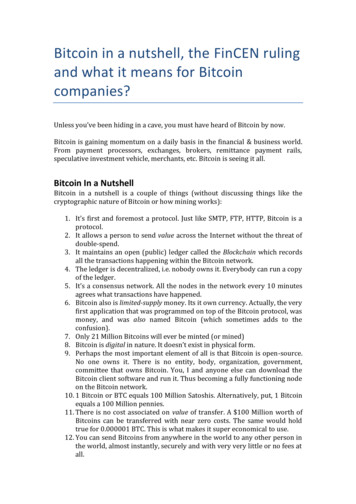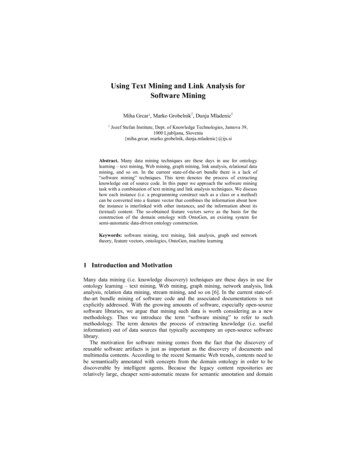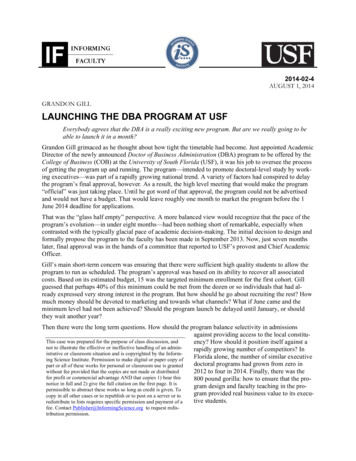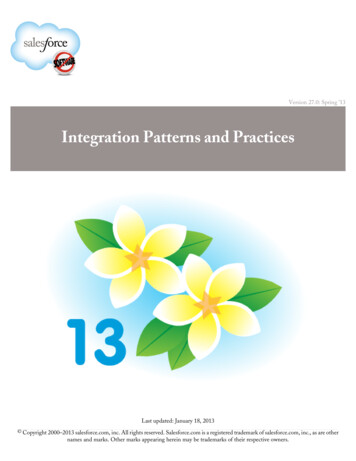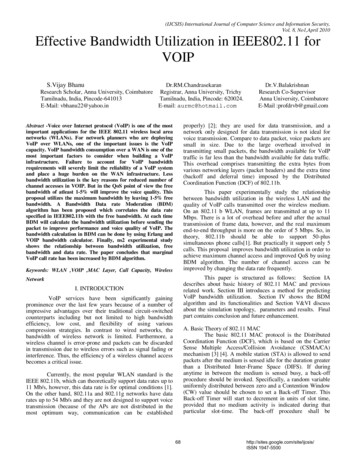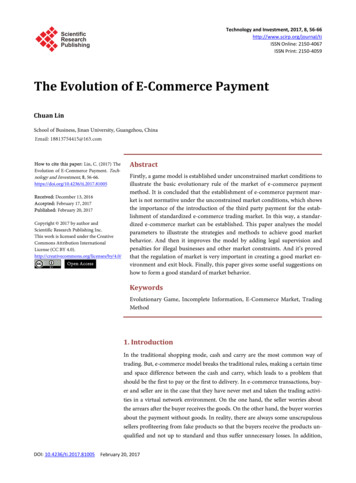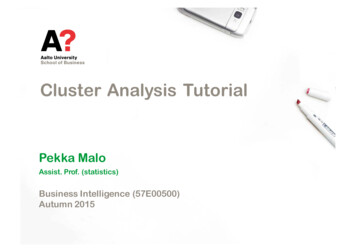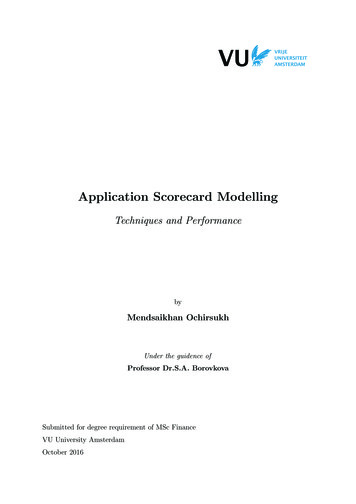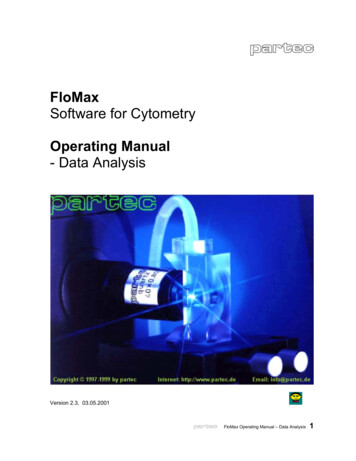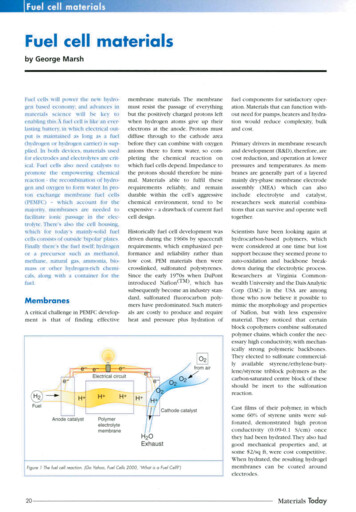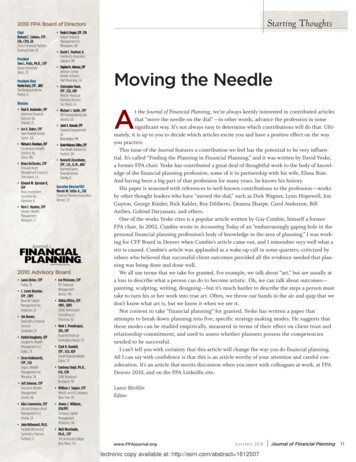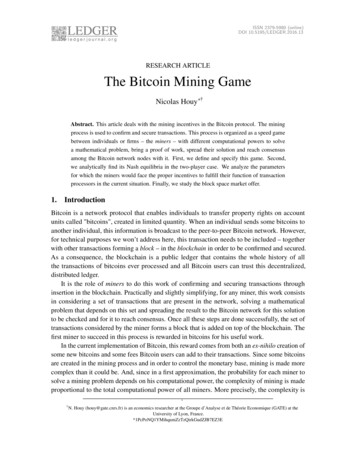
Transcription
ISSN 2379-5980 (online)DOI 10.5195/LEDGER.2016.13RESEARCH ARTICLEThe Bitcoin Mining GameNicolas Houy †Abstract. This article deals with the mining incentives in the Bitcoin protocol. The miningprocess is used to confirm and secure transactions. This process is organized as a speed gamebetween individuals or firms – the miners – with different computational powers to solvea mathematical problem, bring a proof of work, spread their solution and reach consensusamong the Bitcoin network nodes with it. First, we define and specify this game. Second,we analytically find its Nash equilibria in the two-player case. We analyze the parametersfor which the miners would face the proper incentives to fulfill their function of transactionprocessors in the current situation. Finally, we study the block space market offer.1.IntroductionBitcoin is a network protocol that enables individuals to transfer property rights on accountunits called "bitcoins", created in limited quantity. When an individual sends some bitcoins toanother individual, this information is broadcast to the peer-to-peer Bitcoin network. However,for technical purposes we won’t address here, this transaction needs to be included – togetherwith other transactions forming a block – in the blockchain in order to be confirmed and secured.As a consequence, the blockchain is a public ledger that contains the whole history of allthe transactions of bitcoins ever processed and all Bitcoin users can trust this decentralized,distributed ledger.It is the role of miners to do this work of confirming and securing transactions throughinsertion in the blockchain. Practically and slightly simplifying, for any miner, this work consistsin considering a set of transactions that are present in the network, solving a mathematicalproblem that depends on this set and spreading the result to the Bitcoin network for this solutionto be checked and for it to reach consensus. Once all these steps are done successfully, the set oftransactions considered by the miner forms a block that is added on top of the blockchain. Thefirst miner to succeed in this process is rewarded in bitcoins for his useful work.In the current implementation of Bitcoin, this reward comes from both an ex-nihilo creation ofsome new bitcoins and some fees Bitcoin users can add to their transactions. Since some bitcoinsare created in the mining process and in order to control the monetary base, mining is made morecomplex than it could be. And, since in a first approximation, the probability for each miner tosolve a mining problem depends on his computational power, the complexity of mining is madeproportional to the total computational power of all miners. More precisely, the complexity is †N. Houy (houy@gate.cnrs.fr) is an economics researcher at the Groupe d’Analyse et de Théorie Economique (GATE) at theUniversity of Lyon, France.*1PcPoNQ1YMihqumZzTzQirkGudZJB7EZ3E
LEDGER VOL 1 (2016) 53-68dynamically adjusted so that a block solving – and hence a creation of bitcoins – occurs everyten minutes in expectation. Once a block is inserted in the blockchain, the mathematical problemfaced by all miners are modified and we can consider that a fresh new speed game starts betweenminers. Hence, the whole building of the blockchain can be considered as independent blockinsertions from the miners’ point of view.In this article, we tackle the question of the incentives faced by the miners as a function ofthe reward scheme and values. First, let us see the possible gains for a miner. As it is today,the fixed reward is 25 bitcoins (BTC) per block. The variable reward is typically 10 4 BTC pertransaction today but it can also be considered as the price on the market for space in blocks.1Second, let us see the cost structure. When mining a block, a miner is free to choose which ofthe transactions in the network he wishes to include in the block he is trying to solve. In a verygood first approximation, computing the mining mathematical problem with more transactionsincluded in it is not more expensive in terms of CPU, disk or bandwidth use. However, it shouldbe considered that the larger a block, the longer it takes for it to be spread in the Bitcoin networkand reach consensus. Then, including transactions in a block can have the adverse effect oflowering the probability of a miner to earn any reward. When a block is mined but is outracedby another one, it becomes orphaned and all associated rewards are lost for its finder. Then,there exists a tradeoff problem that sets the number of transactions miners should include in theirblocks. However, as we will show, the solution to this tradeoff depends on how many transactionsother miners include in the block they are trying to mine. Then, the number of transactionsincluded in blocks is the outcome of a game: the Bitcoin mining game that we propose to studyin this article. Notice that our study is inspired by the qualitative intuitions given by Andresen.19It is also of importance in the current context of hot debates about the block size limit that shouldbe imposed in the Bitcoin protocol. Indeed, this debate is much about the transaction spaceoffer function of miners. For instance, Rizun constructs this offer function in a decision theoryframework considering the costs and benefits mentioned above and atomistic miners.29 In thisarticle, we show that the game theory framework is more adapted to tackle this question.In Section 2, we describe the Bitcoin mining game. In Section 3, we analytically studythe Nash equilibria of this game in the case of two miners. In Section 4, we study the currentsituation of the Bitcoin mining environment. We show that Bitcoin miners are currently notplaying strategies of a Nash equilibrium for the typical fee.2 Indeed, a unilateral deviation byany miner could increase his benefit by about 1%. We also show that with the current incentives,all miners should simply play the strategy of including no transaction in their blocks. Finally,we will show that, ceteris paribus, the equilibrium where no miner includes a transaction in ablock will stop being one in about 5 years or today if the transaction fee is increased by a factorgreater than 3. In Section 5, we study implications in terms of block space market offer. Section6 concludes.2.ModelLet us consider a set N {1, ., N} of miners in the Bitcoin network with N 2.3 Each mineri N has a relative computational power hi 0 such that h j 1. Miners play against eachj Nother in a race to find the solution of a mathematical problem. This mathematical problem is54ISSN 2379-5980 (online)DOI 10.5195/LEDGER.2016.13
LEDGER VOL 1 (2016) 53-68solved by a try and guess strategy and the occurrence of solving the problem can be modeled as arandom variable following a Poisson process. As explained in the introduction, the complexityof finding a block is dynamically adjusted so that this operation takes T 600 seconds inexpectation. Then, the mining Poisson process has a fixed parameter T 1 for the whole networkof miners.The set of transactions included in a block to be solved is chosen by each miner. This sethas no effect on the cost to solve it in a first approximation. However, once a miner has founda block with a given set of transactions in it, he needs to broadcast his solution to the Bitcoinnetwork and his solution must reach consensus. The time needed for a block to reach consensusis dependent on its size and hence on the set of transactions in it. Let τ(Q) be the time neededfor a block with size Q to reach consensus. We will make the assumption that this time functionis linear, τ(Q) z.Q with z 0.4 The first miner to find a block that reaches consensus earns (inbitcoins) a fixed reward, R 0, and a variable one, ρ.Q, with ρ 0 the fee density.2.1. Mining payoffs—Let us first compute the mining benefit earned by miners. We assumethat all miners start trying to find a new block at the same time, t 0. Each miner i N tries to mine a block with size Qi 0, with, for the sake of simplicity, Qi R . Let Q (Q1 , ., QN )be the sequence of sizes for the next block to be found, one for each miner. Obviously, usingstandard Poisson process results, the probability for i to find a block between t and t dt andthat this block will be the first to reach consensus is:6 exp( h j T 1 (t τ(Qi ) τ(Q j ))) hi T 1 dt. (1)j N,t τ(Qi ) τ(Q j ) 0 After simple calculation, for any miner i N, the probability Pi ( Q ) to find a block and that thisblock will be the first to reach consensus is the integral of Equation 1 between t 0 and t . Itcan be rewritten asZ Pi ( Q ) hi T 1exp T 1 (1 Bi ( Q ,t))(t τ(Qi )) Ai ( Q ,t) τ( Q ) dt,t 0where τ( Q ) h j τ(Q j ),j Nand i N, t 0,6 Bi ( Q ,t) h j 1(τ(Q j ) t τ(Qi )),j N Ai ( Q ,t) h j τ(Q j )1(τ(Q j ) t τ(Qi )).j N The expected reward Πi ( Q ) is equal to the probability to find the first block to reach consensustimes the reward if this is the case. Πi ( Q ) (R ρ.Qi )Pi ( Q ).(2)The following proposition is straightforward from Equations 1 and 2.7 Proposition 1. Let i N and Q (R )N .55ISSN 2379-5980 (online)DOI 10.5195/LEDGER.2016.13
LEDGER VOL 1 (2016) 53-68 Πi ( Q ) 0, Qj Πi ( Q ) 0 whenever (R ρ.Qi ) 0,(2) [] j N \ {i}, Qj Πi ( Q ) 0 whenever ρ 0 and R 0,(3) [] Qi Πi ( Q )(4) [] 0 whenever ρ 0 and R 0. Qi(1) [] j N \ {i},Proposition 1 ((1)-(2)) shows that considering larger blocks by a miner has positive externalities on other miners. Indeed, when a miner i N tries to solve a larger block, he makes thetime needed to spread his block longer, in turn allowing more time for other miners to find thenext block, spread it to the network and reach consensus with it. Then, the expected profit of aminer increases with the size of blocks other miners consider. However, notice that this does notimply that the expected reward Πi is necessarily a decreasing function of Qi . Indeed, because theset of transactions in a block is not constant, the mining race is not a constant-sum game. Moreprecisely, it is true that trying to solve a larger block decreases i’s probability to find it and reachconsensus with it first (Proposition 1 ((3)-(4))). But it also increases the reward he earns in casehe is actually the first one to find and spread the next block to consensus. Notice also that, ingeneral, considering a larger block by a miner modifies the marginal – with respect to their ownblock size decisions – probability of other miners to be rewarded. This implies that the decisionsregarding the sizes of their blocks by miners should be treated in a game theoretical frameworkrather than in a decision theoretical framework.Proposition 2 shows that the sum of the expected rewards for all miners has no maximumsince it increases with the size of blocks and we considered for now that this value has no upperlimit.8 Proposition 2. Let ρ 0 and let Q , Q0 (R )N . If Q Q0 , then Πi ( Q ) Πi (Q0 ).i Ni NNotice that, obviously, when ρ 0, the sum of the expected rewards equals R regardless of Q and Proposition 2 does not apply.Finally, we will need the following lemma in the remainder of our article. Assume thatall miners consider blocks with the same size, formally, i N, Qi Q. Then, for each mineri N, the probability to earn the reward associated with a block solving is just the probability tosolve the mining mathematical problem first and hence is directly proportional to the relative computational power hi . Formally, in this case, i N, t 0, Ai ( Q ,t) Bi ( Q ,t) 0 andLemma 2.1 is proved with simple calculation. Lemma 2.1. Let Q (R )N be such that i N, Qi Q. Then, for all i N, Pi ( Q ) hi and Πi ( Q ) (R ρ.Q)hi .2.2. The Bitcoin mining game—We call the Bitcoin mining game, the gameG (N, (Si )i N , (Πi )i N ) where N is the set of players, (Si )i N with i N, Si R is theset of strategies and (Πi )i N as described in Equation 2 is the set of payoff functions.For each miner i N, the correspondence of best response for the size of the block to mine,56ISSN 2379-5980 (online)DOI 10.5195/LEDGER.2016.13
LEDGER VOL 1 (2016) 53-68Bi , is given by solving the following maximization program. Bi ( Q i ) arg max Πi ( Q ).(3)Qi R with the usual meaning for the notation Q i (Q1 , ., Qi 1 , Qi 1 , ., QN ). Let E (R )N be the set of Nash equilibria of the Bitcoin mining game. Formally, Q (Q 1 , ., Q N ) (R )N , Q E if and only if i N, Q i Bi (Q i ).3.The two-miner caseFor the sake of simplicity, we now concentrate on the case with N 2 even though most ofour results can be generalized to the N 2 case with no logical difficulty but at the price ofcumbersome calculation.9Let us consider the Bitcoin mining game G with N {1, 2}. For any miner i N, ifQi Q3 i ,10 then t 0, Ai ((Q1 , Q2 ),t) Bi ((Q1 , Q2 ),t) 0. Then, the expected rewardearned by miner i is Πi (Q1 , Q2 ) (R ρ.Qi )hi exp (1 hi )T 1 (τ(Qi ) τ(Q3 i )) .Following, assume Qi Q3 i , the expected reward earned by miner i is Πi (Q1 , Q2 ) (R ρ.Qi ) 1 (1 hi ) exp hi T 1 (τ(Q3 i ) τ(Qi )) .Our first result is rather trivial and follows directly from Proposition 1((3)). When ρ 0 andR 0,11 considering a larger block has the only consequence to make longer the period neededfor a miner’s block to reach consensus. The marginal reward associated with this inclusion is 0.Hence, there are only negative incentives for miners to include transactions in blocks.Proposition 3. Let ρ 0 and R 0. The Bitcoin mining game has a unique Nash equilibrium(Q 1 , Q 2 ) (R )2 with Q 1 Q 2 0. Moreover, Π1 (Q 1 , Q 2 ) h1 R and Π2 (Q 1 , Q 2 ) h2 R.For non trivial cases with ρ 0, let us first concentrate on the game with symmetric computational power, h1 h2 1/2. In this case, there exists a unique Nash Equilibrium and it issymmetric.Proposition 4. Let ρ 0. Assume h1 h2 1/2. The Bitcoin mining game has a unique Nash2TRequilibrium (Q 1 , Q 2 ) (R )2 with Q 1 Q 2 max 0, . Moreover, Π1 (Q 1 , Q 2 ) zρ ρ.T Π2 (Q1 , Q2 ) max R/2,.zNow, let us study the asymmetric case. With no loss of generality, let us assume h1 h2 .Proposition 5. Let ρ 0. Assume h1 h2 . The Bitcoin mining game has a unique Nash equilibrium (Q 1 , Q 2 ) (R )2 withTR 0, Q 1 Q 2 0.z(1 h1 ) ρTRTR if 0, Q 1 Q 2 0.z(1 h1 ) ρz(1 h1 ) ρ if57ISSN 2379-5980 (online)DOI 10.5195/LEDGER.2016.13
LEDGER VOL 1 (2016) 53-68Then, in the asymmetric case, we can notice that in all cases, the size of the block looked forby the miner with the greatest computational power is larger than the size of the block looked forby the miner with the lowest computational power. Moreover, there is a set of parameters forwhich considering the smallest block possible for both miners is the only Nash equilibrium of theBitcoin mining game. Now, the question is to know whether this set of parameters is relevant toBitcoin. One way to check this is to study the Bitcoin environment as it is today.4.The current caseIn this Section, we study the current behavior of the miners in the Bitcoin network. In fact,miners can be mining pools but, for the sake of simplicity,12 we will make no difference aswe will consider that the best strategy for a miner is the same whether it is a pool or a singleminer, benefits being redistributed among the participants of a mining pool, proportionally to thecomputational power they bring along to their pool. All the data we need for this study is publicin the Bitcoin blockchain and protocol or relies on the simplifying assumption that, today, allminers include all the transactions present in the network when trying to find a block.13 We willalso work with a typical fee of 10 4 BTC per 0.6kB transaction. Unless otherwise stated, thevalues for our computations are displayed in Table 1.Table 1. Data values.DataValueDimensionDescription and SourceT600secondBitcoin protocol parameter.s0.6kBAverage transaction size,statistics from the blockchain.z0.017second.kB-1Marginal time needed to reach consensusper kB.29, 31, 32zs0.0102c 4second.tx-1Marginal time needed to reachconsensus per transaction (tx), z s.10BTCTypical fee for alow priority 0.6 kB transaction.R25BTCBitcoin protocol currentimplementation parameter.Let us start our analysis of the current situation as displayed in Table 2. In reality, transactionscan have different sizes and require different levels of fees to be computed. The size of atransaction depends on many parameters (number of inputs and outputs mainly) but not directlyon the amount paid in the transaction. Throughout this section, we will make the simplifyingassumption that all transactions have the same size. 884 is the average number of transactions inthe blocks inserted in the blockchain between blocks 377,261 and 378,260. The average size of atransaction over the same period is 600 bytes.We will also consider that the Bitcoin network computational power is distributed as shown inTable 2 (column B). We inferred these relative computational powers of miners from an analysis of58ISSN 2379-5980 (online)DOI 10.5195/LEDGER.2016.13
LEDGER VOL 1 (2016) 53-68the blocks found. Indeed, we make, as already noted, the assumption that all miners include all thetransactions in the network in their blocks. Formally, with our notation, i N, Qi 884 0.6kB.Then, by Lemma 2.1, the probability to solve a block for any miner is exactly equal to his relativecomputational power. Further, we make the assumption that the frequency of blocks found by aminer, that we can observe, is the best estimation of the probability that he solves a block and,hence, the best estimation of his relative computational power.We can now consider each miner and compute his best response to the other miners’ currentstrategy. This optimal number of 0.6kB transactions to include in the current computed block is0 for all miners (column D). This shows that the current situation is not a Nash Equilibrium andall miners have a profitable deviation. If unilaterally mining blocks with no transaction, a minerwould increase his probability to earn the fixed 25 BTC reward (as displayed in column E) atthe cost of the 884 10 4 0.0884 BTC variable reward in case of successful mining. In thecurrent case, this deviation would lead to a higher expected benefit (columns F,G).Table 2. A: miner’s name, B: relative computational power, C: expected reward when i N, Qi 884 0.6kB, D: optimal number of transaction included by miner i in the currentblock when j N \ {i}, Q j 884 0.6kB (solution to Equation 3), E: probability to be thefirst miner to find a block reaching consensus when j N \ {i}, Q j 0.6kB and Qi givenin D, F: expected reward when j N \ {i}, Q j 884 0.6kB and Qi given in D, G: F-Cdifference in %. H: expected reward of miners in BTC when i N, Qi er8.100%2.0321608.212%2.052951.023%2.025BW 00%1.7311006.996%1.749121.041%1.72521 %0.4766801.928%0.482001.116%0.475Telco 03500.406%0.101501.139%0.100Kano CKPool0.300%0.0752700.304%0.076121.141%0.075Solo b l.org0.100%0.0250900.102%0.025381.144%0.025We can also check that all miners including no transaction in the block they are mining59ISSN 2379-5
The Bitcoin Mining Game . †N. Houy (houy@gate.cnrs.fr) is an economics researcher at the Groupe d’Analyse et de Théorie Economique (

